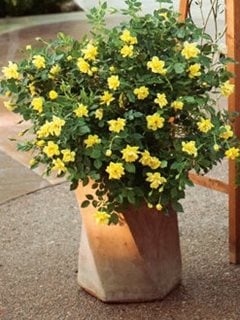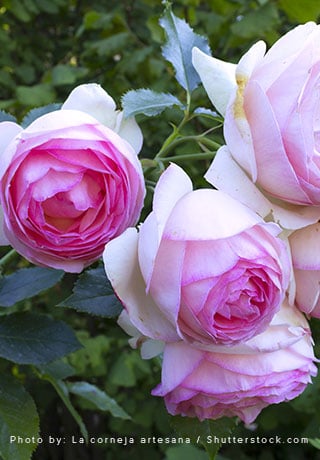How to Grow Beautiful Container Roses
Tips for planting, growing, and caring for a patio-friendly rose garden
At Last® rose. Photo by: Proven Winners
9 Steps for Beautiful Potted Roses:- Grow the right rose.
- Choose the right pot.
- Plant in good soil.
- Provide plenty of sun.
- Water often.
- Fertilize correctly.
- Prune as needed.
- Overwinter properly.
- Know when to repot.
With their intoxicating fragrance, velvety petals, and gorgeous colors, roses deserve to be enjoyed at close range rather than from afar, in a distant garden bed. Planting your roses in containers—whether pots, window boxes, or hanging baskets—allows you to grow a small rose garden on a sunny patio, balcony, deck, or windowsill, where you can appreciate those lovely blooms the most.
As a bonus, you can also control the growing conditions of your plants, a big plus if your garden has too much shade, infertile soil, or poor drainage. Although container roses are easy to grow, even for a novice rosarian, you should follow these important tips to ensure healthy plants and beautiful, nonstop blooms.
1. GROW THE RIGHT ROSE
Just about any type of rose can be grown in a container, but those ideally suited for the job include miniature roses, polyanthas, minifloras, and small shrub roses. Even groundcover roses perform well in containers, especially hanging baskets and window boxes, where they can spill over a patio or other outdoor living space.
If you want to create vertical interest, try growing a tree rose (also called a “standard”), a compact rose bush grafted to a trunk to give the appearance of a small tree.
For the best floral display, choose rose varieties that are repeat bloomers versus types that only bloom once per season. Many newer rose cultivars will flower continuously from early summer through fall.
Learn more about the various types of roses.
2. CHOOSE THE RIGHT POT
Choose a container in proportion to the size of your rose—one that is large enough to accommodate the root ball while offering ample room for growth. Generally, the larger the pot the better because the roots can go deeper, soil temperatures will remain cooler, and the soil will dry out more slowly. The downside to large pots is that they are heavy, so it’s best to place them where they will remain for the season or on wheeled stands that will allow you to move them easily.
To help keep the roots cool and comfortable, avoid dark-colored pots, which absorb more heat, and plant your roses in larger containers that will hold more soil.
There are a number of container types you can choose from, ranging from old whiskey barrels to lightweight fiberglass or resin planters (see these tips for choosing the right container). Whatever type of pot you choose, make sure it has drainage holes or add some holes yourself with a drill. Containers without sufficient drainage can lead to root rot.
3. PLANT IN GOOD SOIL
A necessity for thriving container roses is rich, fertile potting soil. Use a high-quality soilless mix, amending it with compost for an extra nutritional boost. You can also mix some perlite into the soil to improve drainage.
Never use garden soil or topsoil in your containers. These soils are fine for garden beds but they are too dense and heavy for potted plants and won’t permit the air circulation and water flow necessary for healthy root growth. (See more: Potting Soil 101)
4. PROVIDE PLENTY OF SUN
For the best blooms, place your container roses in a location receiving at least six hours of sun daily. Although more sun is usually better, too much can overheat the container and stress the roots, especially in hot weather or in warmer climates.
5. WATER OFTEN
It is vital to keep container roses well watered, since the soil tends to dry out quickly. Water whenever the top inch of soil feels dry to the touch, saturating the soil until water runs from the drainage holes and soil media no longer bubbles. Daily watering may be needed during the heat of the summer, even if the container is a large one.
"I know if I’m late watering a pot, then water runs out right away because the root ball is so dry it is shedding water. But soon enough, water will absorb into the root ball and it will start bubbling, indicating those air spaces are being filled with water." —Denise Kelly, horticulturist
If your lifestyle doesn’t permit daily watering of your potted roses, try planting them in self-watering containers, such as AquaPots, which can reduce the time between waterings to once a week or even longer. Or, use a container watering system such as WaterWise®
(Video: Using Drip Irrigation to Water Your Container Plants).
6. FERTILIZE CORRECTLY
Roses also need a lot of nutrients to sustain their blooms, and container roses will require more frequent fertilizing than those grown in the garden. To get your container roses off to a good start, work a slow-release granular rose fertilizer into the potting soil when planting them, along with a handful of bone meal for healthy root development.
Because frequent watering washes nutrients out of pots, a liquid rose fertilizer applied every 4 to 6 weeks will help to keep your plants in bloom all season. Learn more about how to fertilize roses.
7. PRUNE AS NEEDED
Most miniature and compact roses require very little pruning, and many newer varieties are self-cleaning, eliminating the need for deadheading. If you do need to prune your container roses to maintain their shape or remove unwanted growth, use the same techniques as those recommended for standard-size rose bushes (see more on how to prune roses.
8. OVERWINTER PROPERLY
Because roses are hardy perennials, they can live for many years in their containers if you give them a little TLC during cold weather. Here are some of your winterizing options:
- When your rose plants go dormant in the fall, store them in their pots in an unheated garage or garden shed so the roots won't freeze and then move the pots back outdoors in the spring.
- For containers that are too large to be moved easily, keep the soil warm by placing a thick layer of mulch on the surface and wrap the plant with burlap to shelter it from the wind.
- If you have enough garden space, remove the plants from their pots once they go dormant and plant them in the ground, where the roots will be better protected. In early spring, as soon as the ground thaws, you can dig up your plants and repot them.
9. KNOW WHEN TO REPOT
If you plan to keep your roses in containers long-term, they will eventually need to be transplanted to larger pots to give the roots more growing room. Even if they don’t outgrow their containers, you should replenish the soil every few years to keep your plants healthy. Because roses are heavy feeders, they will deplete the soil of nutrients over time.
The best time of year to repot your roses is in winter or early spring, when the plants are dormant. This is also a good time to root prune your roses if they are becoming root bound.
6 GREAT ROSES FOR CONTAINERS
OSO EASY ITALIAN ICE®Buy now from Proven Winners
Multicolored blooms in soft shades of pink, peach, and yellow put on a repeat performance all summer, set off by glossy, dark green foliage. Highly disease resistant and self-cleaning, eliminating the need for deadheading.
Bloom time: Early to late summerHeight/spread: 18 to 30 inches tall and wide
Zones: 4-9
Container role: Use alone or as a thriller in mixed container plantings.
RINGO ALL-STAR™Buy now from Proven Winners
What this rose lacks in petal count (only five per flower) it more than makes up for in color intensity, with the blooms starting out a luscious melon-orange with cherry-red centers and then turning lavender and pink as they age.
Bloom time: Summer through fallHeight/spread: 3 feet tall and wide
Zones: 4-8
Container role: Use alone or as a filler in mixed container plantings.
Proven Winners' 2023 National Rose of the Year
OSO EASY® MANGO SALSABuy now from Proven Winners
Petals in vivid shades of salmon and coral pink are further intensified by bright yellow stamens. The glossy green foliage forms a tidy mound that works well in containers and garden beds with limited space.
Bloom time: Midsummer through late fallHeight/spread: 2 to 3 feet tall and wide
Zones: 4-9
Container role: Definitely a thriller. Use in any container arrangement that cries out for a brilliant burst of color.
ANNE BOLEYN English Shrub Rose
This floriferous English rose bears large sprays of cup-shaped, soft pink blooms on a neatly rounded shrub with gracefully arching branches. Repeat blooming and highly disease resistant.
Bloom time: Late spring to fallHeight/spread: 3 to 4 feet tall and wide
Zones: 5-11
Container role: Looks lovely alone in a large patio pot or planted in pairs to flank an entryway.
JULIA CHILD™
Enamored by the buttery golden-yellow flowers and sweet, spicy fragrance, the renowned chef herself selected this exceptional rose to bear her name. Also an All-American Rose Selections® winner, chosen for its full old-fashioned flowers, good disease resistance, and rounded habit.
Bloom time: June through SeptemberHeight/spread: 2 to 3 feet tall and wide
Zones: 4-8
Container role: Deserves solo treatment in a large patio pot, where the warm yellow blooms and wonderful scent can be fully appreciated.
'THE FAIRY' Polyantha Rose
Bears bunches of pale pink, pompon-like flowers that rebloom in waves after the first flush in late June. Slightly arching branches give it an attractive fan-like shape. Tolerates poor soil and partial shade.
Bloom time: Late spring to late fallHeight/spread: 2 to 3 feet tall and wide
Zones: 5-11
Container role: Allow to gracefully spill from tall containers or window boxes.
RELATED:
Container Plants for Full Sun
Container Plants for Shade
Container Garden Ideas
Success Secrets for Healthy Container Gardens
Growing Lantana in Pots













